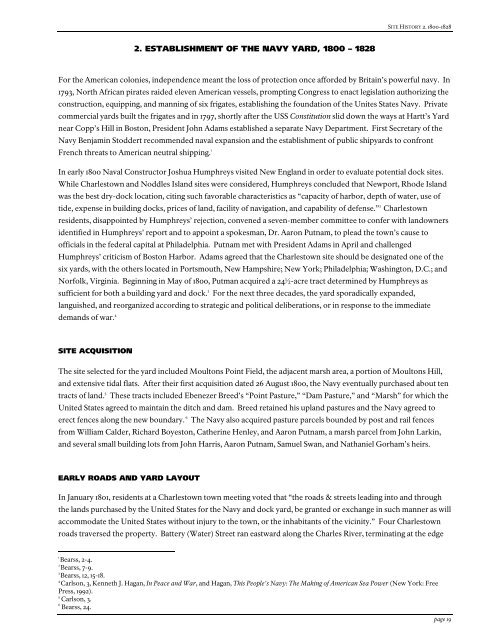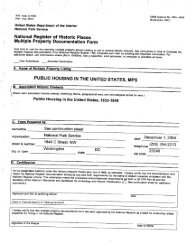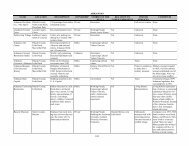Cultural Landscape Report for Charlestown Navy Yard, Boston
Cultural Landscape Report for Charlestown Navy Yard, Boston
Cultural Landscape Report for Charlestown Navy Yard, Boston
You also want an ePaper? Increase the reach of your titles
YUMPU automatically turns print PDFs into web optimized ePapers that Google loves.
2. ESTABLISHMENT OF THE NAVY YARD, 1800 – 1828<br />
SITE HISTORY 2. 1800-1828<br />
For the American colonies, independence meant the loss of protection once af<strong>for</strong>ded by Britain’s powerful navy. In<br />
1793, North African pirates raided eleven American vessels, prompting Congress to enact legislation authorizing the<br />
construction, equipping, and manning of six frigates, establishing the foundation of the Unites States <strong>Navy</strong>. Private<br />
commercial yards built the frigates and in 1797, shortly after the USS Constitution slid down the ways at Hartt’s <strong>Yard</strong><br />
near Copp’s Hill in <strong>Boston</strong>, President John Adams established a separate <strong>Navy</strong> Department. First Secretary of the<br />
<strong>Navy</strong> Benjamin Stoddert recommended naval expansion and the establishment of public shipyards to confront<br />
French threats to American neutral shipping. 1<br />
In early 1800 Naval Constructor Joshua Humphreys visited New England in order to evaluate potential dock sites.<br />
While <strong>Charlestown</strong> and Noddles Island sites were considered, Humphreys concluded that Newport, Rhode Island<br />
was the best dry-dock location, citing such favorable characteristics as “capacity of harbor, depth of water, use of<br />
tide, expense in building docks, prices of land, facility of navigation, and capability of defense.” 2 <strong>Charlestown</strong><br />
residents, disappointed by Humphreys’ rejection, convened a seven-member committee to confer with landowners<br />
identified in Humphreys’ report and to appoint a spokesman, Dr. Aaron Putnam, to plead the town’s cause to<br />
officials in the federal capital at Philadelphia. Putnam met with President Adams in April and challenged<br />
Humphreys’ criticism of <strong>Boston</strong> Harbor. Adams agreed that the <strong>Charlestown</strong> site should be designated one of the<br />
six yards, with the others located in Portsmouth, New Hampshire; New York; Philadelphia; Washington, D.C.; and<br />
Norfolk, Virginia. Beginning in May of 1800, Putman acquired a 24½-acre tract determined by Humphreys as<br />
sufficient <strong>for</strong> both a building yard and dock. 3 For the next three decades, the yard sporadically expanded,<br />
languished, and reorganized according to strategic and political deliberations, or in response to the immediate<br />
demands of war. 4<br />
SITE ACQUISITION<br />
The site selected <strong>for</strong> the yard included Moultons Point Field, the adjacent marsh area, a portion of Moultons Hill,<br />
and extensive tidal flats. After their first acquisition dated 26 August 1800, the <strong>Navy</strong> eventually purchased about ten<br />
tracts of land. 5 These tracts included Ebenezer Breed’s “Point Pasture,” “Dam Pasture,” and “Marsh” <strong>for</strong> which the<br />
United States agreed to maintain the ditch and dam. Breed retained his upland pastures and the <strong>Navy</strong> agreed to<br />
erect fences along the new boundary. 6 The <strong>Navy</strong> also acquired pasture parcels bounded by post and rail fences<br />
from William Calder, Richard Boyeston, Catherine Henley, and Aaron Putnam, a marsh parcel from John Larkin,<br />
and several small building lots from John Harris, Aaron Putnam, Samuel Swan, and Nathaniel Gorham’s heirs.<br />
EARLY ROADS AND YARD LAYOUT<br />
In January 1801, residents at a <strong>Charlestown</strong> town meeting voted that “the roads & streets leading into and through<br />
the lands purchased by the United States <strong>for</strong> the <strong>Navy</strong> and dock yard, be granted or exchange in such manner as will<br />
accommodate the United States without injury to the town, or the inhabitants of the vicinity.” Four <strong>Charlestown</strong><br />
roads traversed the property. Battery (Water) Street ran eastward along the Charles River, terminating at the edge<br />
1<br />
Bearss, 2-4.<br />
2<br />
Bearss, 7-9.<br />
3<br />
Bearss, 12, 15-18.<br />
4<br />
Carlson, 3, Kenneth J. Hagan, In Peace and War, and Hagan, This People’s <strong>Navy</strong>: The Making of American Sea Power (New York: Free<br />
Press, 1992).<br />
5<br />
Carlson, 3.<br />
6<br />
Bearss, 24.<br />
page 19







